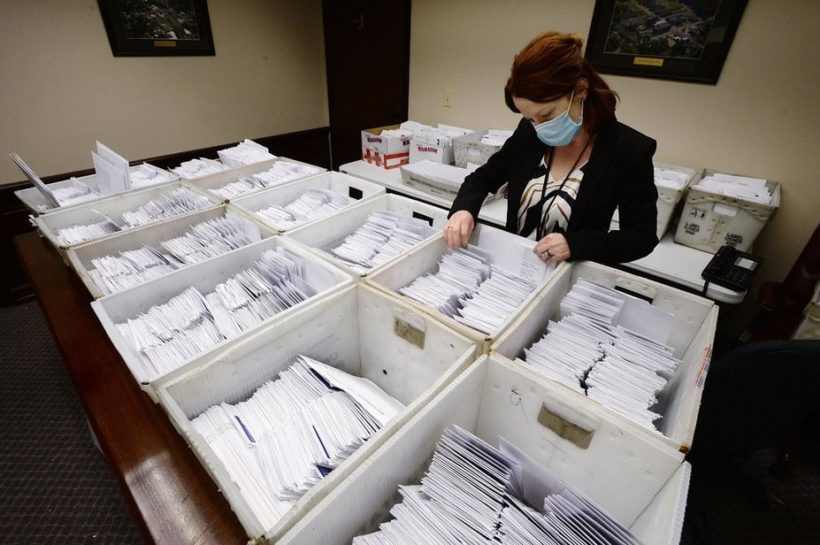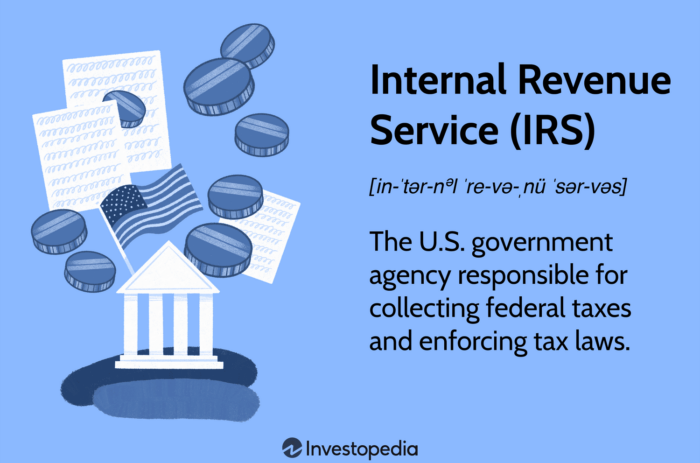
Tonia Fernandez, supervisor of elections, sorts mail-in ballots inside a locked room at the Erie County Courthouse on June 2, 2020.
print Print...
(by Pam Fessler, NPR) – The U.S. Supreme Court said Monday that election officials in Pennsylvania can count absentee ballots received as late as the Friday after Election Day so long as they are postmarked by Nov. 3, [even if they don’t have a clear postmark, as long as there is not proof it was mailed after the polls closed].
The court declined without comment to take up one of the highest-profile election law cases in the final stretch before Election Day. Pennsylvania Republicans had sought to block the counting of late-arriving ballots, which the state’s Supreme Court had approved on September 17.
Republicans sought the emergency stay, arguing that it is up to the state’s legislature — not the court — to set rules for how elections are conducted. They also said the court’s ruling could allow ballots cast after Election Day to be counted [and argued that a deadline extension for receiving ballots violates federal law that sets Election Day as the first Tuesday after the first Monday in November and that such a decision constitutionally belongs to lawmakers, not the courts].
The court’s most conservative justices — Samuel Alito, Neil Gorsuch, Brett Kavanaugh and Clarence Thomas — said they would have agreed to the stay request. But Chief Justice John Roberts joined the court’s three most liberal members – Stephen Breyer, Sonia Sotomayor and Elena Kagan – to reject the request.
[There were no opinions accompanying the order, so it is impossible to say what motivated either group of justices. The conservative justices have been reluctant to allow court-ordered changes to voting rules close to an election.The court also is weighing a similar issue from Wisconsin. But in that case, the ruling being challenged comes from a federal appeals court and it’s the Democrats who are asking the justices to step in.
Most states make Election Day the deadline to receive absentee ballots, but 18 states have a post-Election Day deadline to receive absentee and mail-in ballots].
Many more voters are expected to cast votes by mail this year because of the coronavirus pandemic, and the issue of the cutoff date for when those ballots must be in the hands of election officials has become a legal flashpoint between Democrats and Republicans.
The decision comes in a state that is central to the presidential campaigns of both major-party candidates. Pennsylvania and Wisconsin are the only two swing states where officials can begin processing and counting the millions of absentee ballots only on Election Day, likely delaying complete results for several days. (In a third crucial swing state, Michigan, clerks can begin processing ballots only the day before Election Day.)
In its ruling, the Pennsylvania Supreme Court said that ballots could be counted if they were received by 5 p.m. Nov. 6, as long as they were mailed by Election Day, Nov. 3. It also said that ballots without a postmark would “be presumed to have been mailed by Election Day” unless there was strong evidence to the contrary.
[The Democratic majority* on the state’s high court had cited warnings that postal service delays could invalidate huge numbers of ballots and surging demand for mail-in ballots during the coronavirus pandemic to invoke the power, used previously by the state’s courts, to extend election deadlines during a disaster emergency. *There are 5 elected Democrats, 1 elected Republican and 1 judge appointed by the Democratic governor on Pennsylvania’s state Supreme Court].Before this year, the state required absentee ballots to be received by Election Day. But Democrats pushed for the extension because [they claimed] that postal delays would disenfranchise some of the millions of Pennsylvania voters who are expected to cast their ballots by mail this year because of the pandemic.
The decision is especially important because Donald Trump won Pennsylvania in 2016 by just over 44,000 votes — a narrow margin in a state where more than 6 million ballots were cast. An NPR analysis this year found that tens of thousands of primary ballots — including almost 16,000 in Pennsylvania — were rejected because they arrived too late to be counted.
The question of when mail-in ballots need to be received in order to count has been the subject of litigation in others states as well. In Wisconsin, a federal appeals court recently handed Republicans a victory by [rejecting] a state plan to allow ballots to count if they were received up to six days after Election Day, as long as they were postmarked by Election Day. Democrats have asked the U.S. Supreme Court to reverse that decision.
Last Friday, a federal appeals court ruled that mail-in ballots in Michigan have to be received by Election Day. The state had wanted to extend the deadline by 14 days, arguing that postal delays could cause some ballots to be rejected.
And on Monday, a state appeals court in North Carolina said the state can count ballots that arrive as late as Nov. 12, as long as they are postmarked by Election Day.
Published by NPR .com. Reprinted here for educational purposes only. May not be reproduced on other websites without permission from NPR.
Questions
1. The first paragraph of a news article should answer the questions who, what, where and when. List the who, what, where and when of this news item. (NOTE: The remainder of a news article provides details on the why and/or how.)
2. a) For what reason did Republicans ask the U.S. Supreme Court to hear their challenge to the Pennsylvania Supreme Court’s decision to allow absentee and mail-in ballots to be accepted up to 3 days after Election Day?
b) What do you think of the Republicans’ argument?
3. For what reason did Pennsylvania’s state Supreme Court (which is made up of 5 elected Democratic judges, 1 elected Republican judge and 1 judge appointed by the Democratic governor) rule in favor of the request for the deadline extension?
4. a) Before now, what was the deadline for receiving absentee ballots in Pennsylvania?
b) Why did Democrats in Pennsylvania push for the deadline extension?
c) What do you think of the Democrats’ argument?
5. Democrats across the country support extending mail-in ballot deadlines, saying all voters ballots should be counted and some won’t arrive on time for Election Day due to the Post Office delivery and/or coronavirus. Pennsylvania, Wisconsin and Michigan are all battleground states: in 2016, Donald Trump won each of those states by very small margins.
He won Pennsylvania (and was the first Republican presidential candidate to do so since 1988) by 44,292 votes.
He won Michigan by 10,704 votes, and
he won Wisconsin by 22,748 votes.
A Michigan state judge on September 18 ruled that absentee ballots in Michigan postmarked before Election Day could be counted if they arrive two weeks after the polls close.
A federal appeals court ruled Friday that Michigan’s mail-in and absentee ballots must arrive by Election Day to be valid.
CNN reports:
Previous to this year, only ballots received by 8 p.m. on Election Day could be counted in Michigan — a policy that led to thousands of ballots getting rejected in the state’s August primary. (The same problem occurred in Pennsylvania, but also occurs with absentee ballots in elections every year.)The ruling was a victory for Democratic groups that brought the lawsuit, who have been arguing in Michigan and other battleground states that many late-arriving ballots should still be counted.
Polls show that a larger percentage of Democratic voters are voting with mail-in ballots, while a greater percentage of Republicans are voting in person on election day (or in person on an early voting day).
What do you think:
a) In Pennsylvania, voters ballots will be counted up to 3 days after Election Day as long as they are postmarked by Nov. 3, — even if they don’t have a clear postmark, or no postmark at all, as long as there is not proof it was mailed after the polls closed. What do you think of the postmark ruling?
b) Should voters be given extra time to get their mail-in ballots in? If so, how many days? 3, 6, 10, 14? It will then still take a few days after the deadline for election officials to count the ballots.
c) Should voters be responsible to mail their ballots far enough in advance to ensure they arrive on Election Day, or does this particular deadline put an undue burden on voters, and potentially disenfranchise them? Will multiple deadlines for receiving ballots in various states cause chaos? Explain your answer.
Resources
Visit StudentNewsDaily’s Presidential Election resources page and
2020 General Election resources page.
Daily “Answers” emails are provided for Daily News Articles, Tuesday’s World Events and Friday’s News Quiz.



